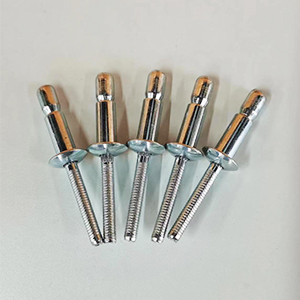Brushed rivets, also known as cup-type blind rivets, are structural blind rivets. After riveting, the broken nails of the mandrel will be flanged into the grooves of the rivet body to lock the mandrel. From the surface, the internal locking wire drawing rivets It is not much different from the outer locking rivet, and the mechanical properties are roughly the same. The main reason is that the locking structure after riveting is different. Under normal circumstances, the inner locking rivet can be used with a conventional rivet gun, and the outer locking rivet needs to be matched with the corresponding rivet Gun use.
1. What is the difference between the use of inner lock wire rivets and outer lock wire rivets?
1. The outer lock wire drawing rivet has a step slightly larger than the inner hole of the brim. After the rivet is fully expanded, under the extrusion action of the rivet mouth boss, a circle of material on the upper part of the rivet core is turned over and filled in the step, which acts as a lock. tight effect.
2. The diameter of the inner wall of the eaves of the inner locking wire drawing rivet is slightly smaller than the inner diameter of the rivet tube. After the rivet is fully expanded, the water chestnut material with a slightly smaller inner diameter will be squeezed into the groove at the lower part of the breaking point of the mandrel to play a locking role.
2. What are the anti-rust methods for wire drawing rivets?
1. Electroplating.
Electroplating rivets, this method is to put the rivets in a metal solution, and then use an electric current to coat a layer of metal on the surface, which has many effects on this layer of metal.
2. Mechanical coating.
The mechanical coating of the rivet is to make the metal particles cold-weld the rivet to ensure that the surface of the rivet has a certain function. Mechanical coating is basically the same as electroplating, but the method is different, and the result is the same.
3. Heat treatment
The surface of the rivet is heat treated. Some rivets are relatively hard. The rivet can be heat treated to ensure that the rivet has sufficient hardness. This is why heat treatment is required.
4. Surface passivation.
The surface passivation of the rivet has two main functions, one is to enhance the hardness of the rivet, and the other is to greatly reduce the degree of oxidation of the rivet.

Previous: What are the functions of rivets?
下一条: No Information
Related News
- What are the functions of rivets?
- How to use blind rivets
- What is a rivet nut?
- Structure introduction and maintenance of rivet gun
- Application of Lantern Rivet Nut
- Classification and application of rivet standoffs
- The working principle and selection rules of riveting gun
- The use of rivet nuts
- Comparison of drawing rivet connection and traditional craftsmanship
- How to use blind rivets



